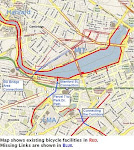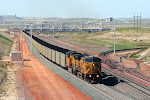 A recently released study from the Federal Railroad Administration (FRA) concludes that railroads are truly more fuel-efficient than truck for freight shipment. As reported by Railway Age , the findings confirm what I’ve know for some time: the lower coefficient of friction of steel on steel translates into less fuel per ton-mile. Adding to the inherent advantage governed by the laws of physics, the FRA also noted technological advances in more fuel-efficient locomotives:
A recently released study from the Federal Railroad Administration (FRA) concludes that railroads are truly more fuel-efficient than truck for freight shipment. As reported by Railway Age , the findings confirm what I’ve know for some time: the lower coefficient of friction of steel on steel translates into less fuel per ton-mile. Adding to the inherent advantage governed by the laws of physics, the FRA also noted technological advances in more fuel-efficient locomotives: “While all types of transportation are vital to the distribution of goods across the country, this study shows that utilizing America’s freight rail system can lead to significant fuel savings,” said FRA Administrator Joseph Szabo (pictured at left). “The environmental benefits of these positive changes over the last two decades are enormous. We look forward to working with the freight rail industry to make sure these gains continue.”
“While all types of transportation are vital to the distribution of goods across the country, this study shows that utilizing America’s freight rail system can lead to significant fuel savings,” said FRA Administrator Joseph Szabo (pictured at left). “The environmental benefits of these positive changes over the last two decades are enormous. We look forward to working with the freight rail industry to make sure these gains continue.”The text of the final report (Comparative Evaluation of Rail and Truck Fuel Efficiency on Competitive Corridors, dated November 19, 2009 ) is even more impressive. Section 1.5 summarizes the main finding:
“For all movements, rail fuel efficiency is higher than truck fuel efficiency in terms of ton-miles per gallon. The ratio between rail and truck fuel efficiency indicates how much more fuel efficient rail is in comparison to trucks. As illustrated in Exhibit 1-1, rail fuel efficiency varies from 156 to 512 ton-miles per gallon, truck fuel efficiency ranges from 68 to 133 ton-miles per gallon, and rail truck fuel efficiency ratios range from 1.9 to 5.5."

Translating that to English, in case you didn't get the impact of it, means that rail is between twice and 5.5 times more fuel efficient!
With ongoing technological development in locomotive efficeincy, the scorecard for rail will only improve more. Already, there are the locomotive equivalent of the Prius. And even more emissions reductions for yard locomotives, to the point where there is even a working battery-powered yard engine prototype being tested.
Add the environmental advantage to rail to the econonomic advantage to the tax payer: every frieght car on privately-owned and maintained, tax-paying freight rail lines saves the equivalent of four trucks pounding the life out of highways and bridges that will be repaired and replaced at taxpayer expense. The economic benefit of rail is truely a two-for: reduces the cost of taxpayer-finances public infrastructure while adding revenue (thus, higher tax payments) for the freight railroads.




